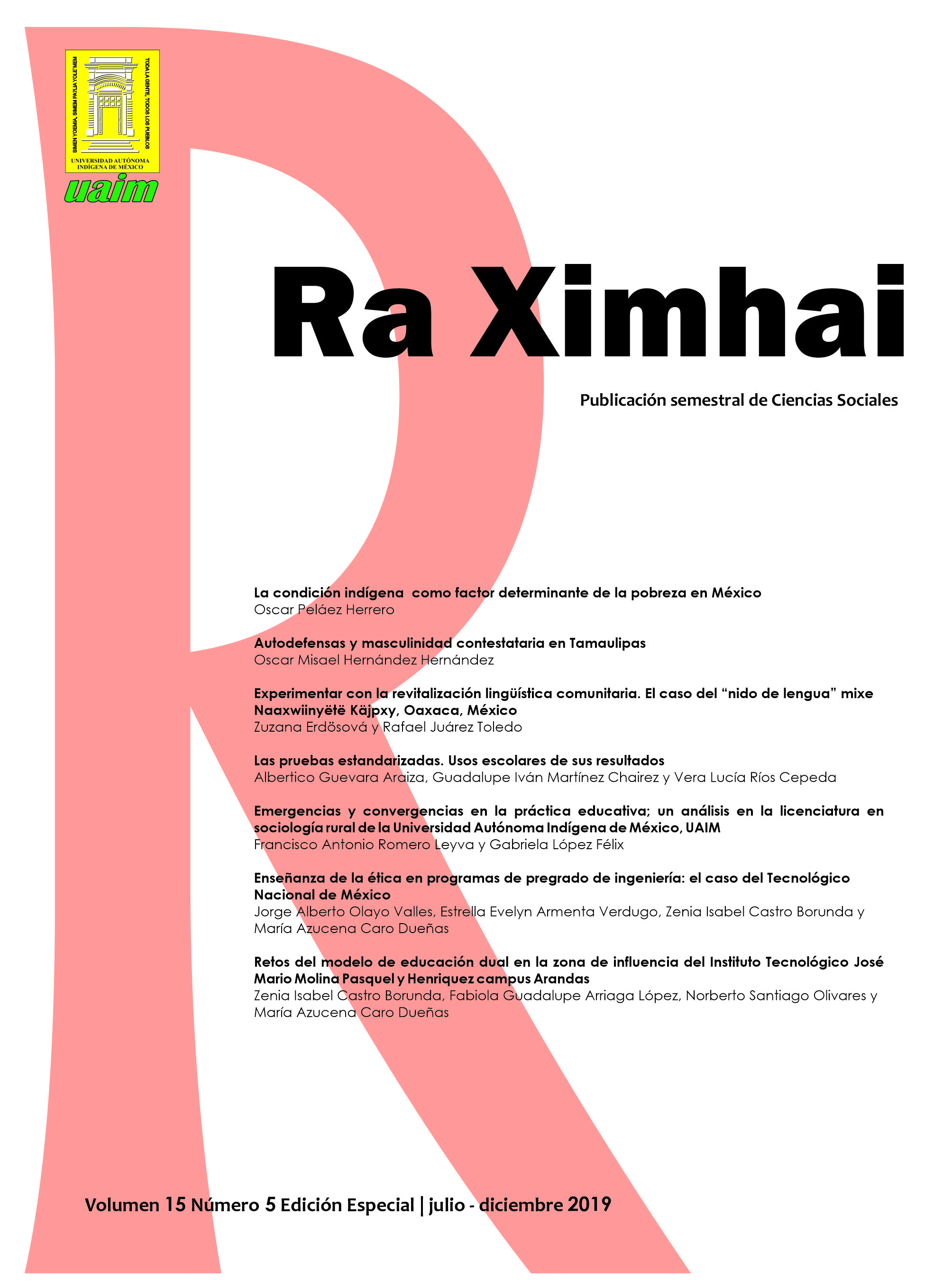Experimenting with community language revitalization. The case of the Naaxwiinyëtë Käjpxy Mixe “language nest”, Oaxaca, Mexico
DOI:
https://doi.org/10.35197/rx.15.05.2019.03.zeKeywords:
language nest, mixe language, linguistic revitalization, Naaxwiinyëtë KäjpxyAbstract
The “language nest” is a language revitalization method of Maori origin focused on preschool children that has been implemented since 2007 in several Mexican indigenous communities, among which those in the Oaxaca region stand out. The experience of the “language nest” of Ayuuk (Mixe) origin called Naaxwiinyëtë Käjpxy (“the talk of the earth”) is presented, which was located on the outskirts of the urban area of the capital of Oaxaca. Apart from being an institutional project, after four years of operation, the project was closed in 2014. It was considered relevant to recover, through qualitative methodology, the
history that highlights the vicissitudes that surrounded the “nest”, from the testimonies of those who served as managers and participants; The information obtained was qualitatively organized under the criteria of good practices, difficulties and recommendations, with the purpose of creating an estimate of its contribution to the revitalization of the Mixe language.
Downloads
References
Barrientos Salinas, A. (2017). Hablemos nuestro idioma con nuestros niños y niñas. La experiencia de los nidos bilingües en Bolivia. Santa Cruz de la Sierra, Bolivia: Instituto Plurinacional de Estudio de Lenguas y Culturas IPELC.
Borgia, M. y Dowdy, S. (2010). Building an Intergenerational, Home-Based Language Nest. Santa Barbara Papers in Linguistics, Vol. 21, pp. 115-127.
Chambers, N. (2014). They all speak Okanagan and I know what they are saying. Language nests in the early years: insights, challenges and promising practices. Tesis doctoral, University of British Columbia.
Černý, M. (2010). Language Death versus Language Survival: A Global Perspective. In Beyond Globalisation: Exploring the Limits of Globalisation in the Regional Context (conference proceedings), 51-56. Ostrava: University of Ostrava Czech Republic, 2010. En http://conference.osu.eu/globalization/publ/06-cerny.pdf.
Cuevas, H. (2013). Encarnizada lucha contra el desarraigo. Oasis ayuuck. Noticias Voz e Imagen de Oaxaca 06/25/2013. Disponible en http://old.nvinoticias.com/oaxaca/157941-oasis-ayuuck.
Edwards, J. (2011). Jugadores y relaciones de poder en escenarios de grupos minoritarios. En José Antonio Flores Farfán (Coord.): Antología de textos para la revitalización lingüística, México: Inali, 55-82.
Embriz Osorio, A. y Zamora Alarcón, O. (Coords.) (2012). México. Lenguas indígenas nacionales en riesgo de desaparición. México: Inali.
Fishman, J. (2011). Tres historias exitosas (más o menos): el hebreo moderno, el francés en Quebec y el Catalán en España. En José Antonio Flores Farfán (Coord.): Antología de textos para la revitalización lingüística, México: Inali, 83-145.
Greymorning, Steve (1997): Going Beyond Words: The Arapaho Immersion Program. En Jon Reyhner (ed.), Teaching Indigenous Languages, Flagstaff, Arizona: Northern Arizona University, 22-30.
Inali (2009). Catálogo de las lenguas indígenas nacionales. México: Inali.
Lewis, M. P. y Simons, G. F. (2010). Assessing endargerment: Expanding Fishman´s GIDS. Revue roumaine de linguistique, vol 55, No. 2, 103-120.
Long Soldier, Layli (Ed.) (2009). Building experiences of Maori and Hawaiian Language Revival. Santa Fe, USA: Indigenous Language Institute. Across Borders Project 2007 funded by the W. K. Kellogg Foundation.
Meyer, L. y Soberanes Bojórquez, Fernando (2009): El nido de lengua. Orientación para sus guías. Oaxaca: CMPIO/CNEII/CSEIIO.
Meyer, L. (2010). Hacia una alternativa de formación indígena bilingüe e intercultural: una pedagogía liberadora desde la “comunalidad”. Revista Latinoamericana de Educación Inclusiva, Vol. 4, No. 1, pp. 83-103.
Parker, A.; Gessner, S. y Michel, K. (2014): Language Nest Handbook for B. C. First Nations Communities. Brentwood Bay, B. C., Canada: First Peoples’ Cultural Council, con Chief Atahm School.
Pfleger, S. (2016). Solo vemos lo que miramos. México: UNAM. Terborg y García 2011.
Soberanes Bojórquez, Fernando y Cano, Mayen (2017): sobre educación. Encuentro. Tu voz digital. En https://soundcloud.com/encuentro-382148369/fernandobojorquezymayemcano-01
Tanat, Ó. (2012). Nido de lenguas: cultivar la lengua entre lo urbano. El Jolgorio Cultural, Noviembre 2012, 24-25.
Trujillo Tamez, I. y Terborg, R. (2009). Un análisis de las presiones que causan el desplazamiento o mantenimiento de una lengua indígena de México: El caso de la lengua mixe de Oaxaca. Cuadernos Interculturales, vol. 7, No. 12, pp. 127-140.
Trujillo Tamez, I. (2011a). La vitalidad de la lengua mixe de San Juan Bosco Chuxnaban. En Roland Terborg y García Landa (Coords.), Muerte y vitalidad de las lenguas indígenas y las presiones sobre sus hablantes, México: UNAM, pp. 63-88.
Trujillo Tamez, I. (2011b). Situación sociolingüística del mixe en San Lucas Camotán. En Roland Terborg y Laura García Landa (Coords.), Muerte y vitalidad de las lenguas indígenas y las presiones sobre sus hablantes, México: UNAM, pp. 89-118.
Vigil Oliveros, N. (2011): Reflexiones de invierno. Lima: Tarea Asociación de Publicaciones Educativas.
Downloads
Published
How to Cite
Issue
Section
License
Copyright (c) 2019 Zuzana Erdösová , Rafael Juárez Toledo

This work is licensed under a Creative Commons Attribution-NonCommercial 4.0 International License.
Usted es libre de:
- Compartir — copiar y redistribuir el material en cualquier medio o formato
- Adaptar — remezclar, transformar y construir a partir del material
- La licenciante no puede revocar estas libertades en tanto usted siga los términos de la licencia
Bajo los siguientes términos:
- Atribución — Usted debe dar crédito de manera adecuada , brindar un enlace a la licencia, e indicar si se han realizado cambios . Puede hacerlo en cualquier forma razonable, pero no de forma tal que sugiera que usted o su uso tienen el apoyo de la licenciante.
- NoComercial — Usted no puede hacer uso del material con propósitos comerciales .
- No hay restricciones adicionales — No puede aplicar términos legales ni medidas tecnológicas que restrinjan legalmente a otras a hacer cualquier uso permitido por la licencia.








